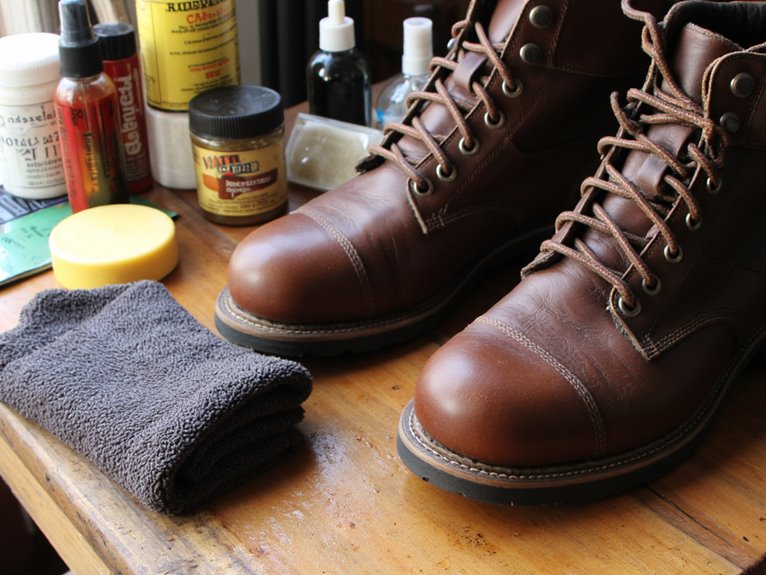Waterproofing Your Hiking Boots: Materials and Methods
Waterproofing your hiking boots requires understanding three key components: base materials, construction features, and maintenance treatments. Full-grain leather offers natural water resistance but needs regular conditioning, while synthetic materials rely on built-in membranes like Gore-Tex. Essential construction elements include gusseted tongues, sealed seams, and padded collars that prevent water entry. You’ll need different treatments for leather versus synthetic boots-wax-based products for leather, DWR sprays for synthetics. Reapply treatments every three weeks or when water stops beading on surfaces to maintain ideal protection and discover advanced techniques.
We are supported by our audience. When you purchase through links on our site, we may earn an affiliate commission, at no extra cost for you. Learn more. Last update on 8th January 2026 / Images from Amazon Product Advertising API.
Notable Insights
- Different boot materials require specific waterproofing approaches: leather needs wax or oil treatments, while synthetic boots need DWR coating maintenance.
- Gusseted tongues, padded collars, and sealed seams are essential construction features that prevent water entry through vulnerable boot areas.
- Clean boots thoroughly with saddle soap before applying waterproofing agents in thin, even coats across seams and high-stress points.
- Reapply waterproofing every three weeks or when water stops beading on the surface and begins soaking into the material.
- Signs your boots need retreatment include persistent wet spots, damp insoles, water absorption instead of beading, and musty odors.
Understanding Boot Materials and Their Waterproof Characteristics
Most hiking boots combine multiple materials to achieve ideal waterproof performance, and understanding these components helps you select boots that’ll keep your feet dry in challenging conditions.
Understanding your hiking boot’s material composition is essential for making informed decisions about waterproof performance in demanding outdoor environments.
Boot material comparisons reveal significant differences in water resistance. Full-grain leather offers natural water resistance through tight fiber structure but requires treatment for complete waterproofing. Suede leather‘s porous nature demands waterproof sprays or waterproof membrane integration.
Synthetic materials like nylon and polyester provide lightweight, quick-drying properties when paired with waterproof membranes. However, waterproofing sprays can be applied but are less effective than built-in options.
Waterproof fabric options include Gore-Tex and eVent membranes that block water while maintaining breathability. PVC-coated materials deliver excellent water resistance but sacrifice breathability. Seams can compromise waterproofing since they typically admit water and create potential points for moisture penetration.
Heavy leather materials typically outlast synthetics in harsh conditions, while lightweight synthetics rely more heavily on specialized membranes for moisture protection.
Construction Features That Impact Water Resistance
While material choice forms the foundation of waterproof performance, construction features determine whether your boots actually keep water out during real-world hiking conditions.
Boot construction methods directly affect water resistance through specific design elements.
Gusseted tongues attach to both upper sides, creating barriers that prevent water entry through lacing areas. Padded, waterproof collars seal ankle openings while extending above standard height for deep puddle protection. Sealed seams eliminate water infiltration through stitching holes using tape or specialized sealants.
Sealing techniques vary by construction type. Cement construction uses waterproof adhesives at sole-to-upper junctions, while laminated membranes bond within upper layers for consistent coverage.
EVA midsoles provide water-resistant cushioning, and fiberglass shanks require proper sealing to maintain integrity. Quality construction relies on durable materials like 500-denier Cordura® nylon that enhance performance in harsh outdoor conditions.
These construction features work together to create extensive waterproof protection. Additionally, seam-sealed construction in waterproof boots prevents water penetration through stitched areas, ensuring reliable performance in wet conditions.
Waterproofing Techniques for Leather Hiking Boots
Three key factors determine successful leather boot waterproofing: proper preparation, correct product selection, and systematic application technique. Start by removing laces and cleaning boots with saddle soap to eliminate debris that blocks waterproofing agents. Allow complete drying at room temperature-never use direct heat sources.
| Product Type | Best Application |
|---|---|
| Waterproofing sprays | Quick penetration into leather pores |
| Mink oil/conditioners | Full-grain leather flexibility restoration |
| Wax-based products | Durable protection with cloth application |
| Lanolin creams | Traditional natural waterproofing method |
Apply treatments in thin, even coats covering seams, tongues, and lace holes. Use 1-2 coats with full curing between layers. Work in ventilated areas when using chemical-based products. Proper leather boot care requires reapplication every three weeks to maintain water repellency and breathability. When selecting waterproofing products, consider options that provide UV protection similar to hiking apparel, as extended sun exposure can degrade both leather and waterproof treatments.
Waterproofing Methods for Synthetic and Fabric Boots
Unlike leather boots that absorb waterproofing treatments deep into their fibers, synthetic and fabric hiking boots require surface-applied treatments that work with existing waterproof membranes.
Synthetic boots need surface treatments that complement waterproof membranes rather than penetrating deep into the material like leather boots.
Most synthetic boots rely on waterproof membrane types like Gore-Tex for protection. These membranes create waterproof barriers while maintaining breathability. You’ll need to apply Durable Water Repellency (DWR) coatings to the outer fabric surface.
Never use wax or oil-based products on synthetic materials-they’ll compromise membrane breathability.
Start with thoroughly cleaned, damp boots. Remove laces and insoles for complete access. Apply DWR sprays like Nikwax Fabric and Leather Proof from 5cm distance, covering all surfaces evenly.
Let boots rest five minutes, then wipe excess product.
DWR reapplication frequency depends on usage intensity. Reapply when water stops beading on the surface. Quality seam-sealed constructions work alongside DWR treatments to provide comprehensive waterproofing for synthetic hiking boots.
Recognizing When Your Boots Need Waterproof Treatment
You’ll know it’s time to retreat your boots when water stops forming beads on the surface and instead absorbs directly into the material.
This loss of water repellency signals that the Durable Water Repellent (DWR) coating has deteriorated beyond effective protection levels.
Watch for persistent wet spots on the outer leather or fabric that remain even after drying, as this indicates the waterproof barrier has been compromised.
Quality waterproof membranes may also degrade over time, reducing their effectiveness against wet trail conditions and requiring replacement or retreatment.
When boots fail to maintain dry conditions in rain, snow, and mud despite previous reliable performance, it’s time to consider seam-sealed construction repairs or complete waterproof retreatment.
Signs of Water Penetration
When water penetration compromises your hiking boots, several distinct warning signs will alert you to membrane failure or sealing problems. Moisture detection begins with damp insoles or wet socks after hiking. Your boots’ waterproof integrity fails when water pools inside after submersion tests lasting 10-15 minutes.
Seam inspection reveals common failure points where stitching creates leak paths. Peeling tape or worn seals indicate probable water entry routes.
| Sign | Location | Cause |
|---|---|---|
| Damp insoles | Interior footbed | Membrane breach |
| Wet spots | Near seam lines | Seal failure |
| Water entry | Boot collar/tongue | Inadequate height |
| Persistent moisture | Throughout interior | Membrane degradation |
| Musty odor | Inner lining | Bacterial growth |
Water seepage over boot collars occurs without membrane damage, particularly in deep snow conditions. While seam-sealed technology provides enhanced waterproofing in quality boots like Columbia models, this protection can deteriorate over time and require reapplication to maintain effectiveness. Proper waterproof shoes should offer both moisture protection and breathability features to prevent internal condensation that can mimic water penetration issues.
Visual DWR Coating Failure
The most reliable indicator of DWR coating failure appears when water droplets stop beading on your boot’s surface and instead soak directly into the fabric or leather.
You’ll notice darker, dampened areas where water absorbs rather than rolls off. The material loses its natural texture and appears visibly wet or clammy.
Perform a simple DWR effectiveness assessment by sprinkling water drops on different boot sections.
Effective coating produces tight beads that roll away immediately. Failed DWR allows water to sit, spread, or darken the surface.
High-friction areas like ankle flexion points typically show accelerated wear patterns.
This breakdown compromises moisture management solutions, reducing breathability and creating internal condensation.
When saturation occurs regularly after rain exposure, your boots require immediate DWR reapplication to restore protective barriers.
Best Practices for Applying and Maintaining Waterproof Protection
Although proper waterproofing can extend your hiking boots’ lifespan by years, the effectiveness depends entirely on thorough preparation and precise application techniques.
Start by removing laces and brushing off loose dirt, then clean with saddle soap or specialized boot cleaner. Your boots should remain damp during treatment-waterproofing agents penetrate better into slightly moist leather than completely dry material.
Follow these essential application techniques and maintenance tips:
- Apply treatments evenly, focusing on seams and stress points where water infiltration occurs most frequently
- Allow each coating to dry completely before adding subsequent layers to prevent ineffective buildup
- Use gentle heat sources like hairdryers to warm wax treatments for deeper leather penetration
- Reapply waterproofing after extensive use or exposure to harsh conditions
Store boots in temperature-stable environments, avoiding extreme heat or cold that compromises treatment integrity. Pair your waterproofed boots with high-quality moisture-wicking socks to create a complete moisture management system that keeps your feet dry from both external water and internal perspiration.
Frequently Asked Questions
How Often Should I Waterproof My Hiking Boots During Heavy Use Seasons?
During heavy use seasons, you’ll need to waterproof your hiking boots every 1-2 months. Follow frequency guidelines based on moisture exposure and make seasonal adjustments for wet conditions requiring more frequent applications.
Can I Waterproof Boots That Are Still Wet From Recent Hiking Trips?
No, you shouldn’t waterproof wet boots. Moisture blocks proper penetration regardless of boot materials. Use proper drying techniques first – air dry completely in ventilated areas for 24+ hours before applying any waterproofing treatments.
Will Waterproofing Treatments Affect the Color or Appearance of My Boots?
Yes, waterproofing treatments can cause color change in your boots. Wax-based products typically darken leather considerably, while sprays have minimal impact. Material compatibility matters – always test on an inconspicuous area first.
Should I Waterproof Brand New Boots Before Their First Use?
Yes, you should waterproof new boots before first use. Initial treatment importance can’t be overstated-it extends lifespan and prevents moisture damage. Check boot material compatibility first, then apply waterproofing while leather’s slightly damp for ideal absorption.
On a final note
You’ve learned the essential techniques for maintaining waterproof protection across different boot materials. Regular inspection prevents water damage before it starts. Apply treatments when water stops beading on surfaces or when fabric shows saturation signs. Follow manufacturer specifications for product compatibility and reapplication intervals. Proper waterproofing extends boot lifespan by 40-60% while maintaining breathability. Your investment in quality treatment products and consistent maintenance guarantees reliable performance in wet conditions.

